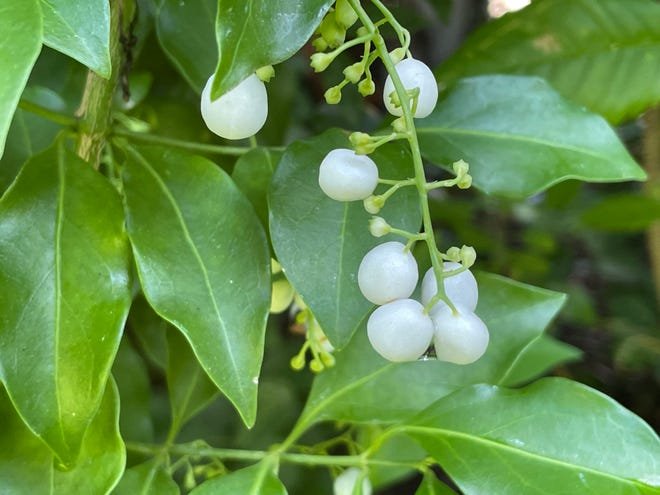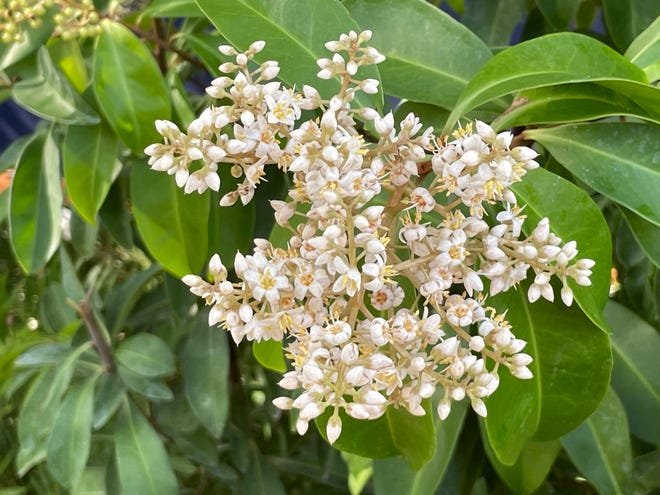South Florida fall flourishes with native plants
Leavenworth’s tickseed (Coreopsis Leavenworth) burst with color
November 18, 2021
While fall symbolizes the end of the growing season in most of the country, it is just the opposite here in South Florida.
My garden is a mass of colorful bloom right now: red salvia, yellow coreopsis and cassia, purple beautyberry, white plumbago, pink lantana, blue ageratum, orange/red firebush and coral honeysuckle are just a few of the natives showing off their finery.
Blue ageratum is now in bloom
More:We saved a native butterfly; now let's save our soils
In the berry department, Simpson stopper has a mass of red, orange and yellow berries next to the deep burgundy ones of wild coffee. Snowberry, with beautiful round bright white fruits beneath shiny green leaves, is a showstopper, and fiddlewood, with panicles of reddish-brown fruits, is lovely at this time of year. Marlberry is full of fragrant white flower clusters that will become deep purplish/black berries.
All these plants are native, requiring no added chemicals to look fabulous, and have brought a wonderful assortment of pollinators, butterflies, and songbirds to my garden.
I went to the Mounts’ Plant sale last weekend for new native specimens to fill some empty spots in my border. Fetterbush (Lyonia lucida) is great for a shady area and I planted it beneath the gumbo limbo. This multi-stemmed low growing shrub has fragrant white-to-pink bell-like flowers in spring and now carries racemes of small round fruit that are proving very popular with garden songbirds. The delicate habit and shiny narrow evergreen leaves make this a lovely border plant tolerant of moist conditions.
I also found some beautiful fiddlewood (Citharexylum fruiticosum), which I am using in planters on the loggia. Fiddlewood is a delightful small tree whose glossy foliage literally glistens in the sunlight. The fragrant white flowers from spring through fall attract butterflies and are followed by graceful racemes of reddish-brown fruits that are sought after by birds. This great native should be more widely used.
Native lantana (Lantana involucrata) is a terrific shrub with clusters of small white flowers that attract numerous butterfly species; I was happy to find several at Jeff Nurge’s booth at Mounts. The dark blue berries often appear at the same time as the flowers, making this a very interesting specimen. Drought- and salt-tolerant, this does well near the coast as well as in open woody clearings. I like it as a background plant, as it reaches a height of 5-6 feet. It can become leggy with age, so just prune it back to maintain its bushy appearance.
More:Green gardening: New plantings at Palm Beach park, marina should be applauded
Snowberry makes a statement in sunny and shady locations
Snowberry (Chiococca alba) is another great native whose bright white fall berries stand out against the shiny green foliage. This gardenia relative, with fragrant clusters of dainty white bell-shaped flowers, makes a wonderful statement in part sun or shade.
Simpson Stopper blooms with red berries this time of the year
Simpson stopper (Myrcanthes fragrans), a fabulous and versatile native tree, has wonderful clusters of reddish-orange berries at this time of year, adding to its other attributes of fragrant blossoms, deep-green glossy foliage and beautiful ornamental bark. This forms the hedge around my garden, augmented by thatch palms, wild coffee, and saw palmetto; it’s a delight watching the birds and pollinators frequenting these trees.
Bahama senna is the host plant for several types of butterflies
Bahama senna (Cassia chapmanii or Senna Mexicana var. Chapmanii) is bursting with bright yellow blooms now that will remain throughout the winter. Quick-growing, drought- and salt-tolerant, this is the larval host plant for the orange-barred sulphur, cloudless sulphur and sleepy orange butterflies, while providing nectar for numerous other skippers and butterflies. The delicate, evergreen foliage of this multi-stemmed shrub will add a graceful, elegant look to your garden.
Marlberry can grow as a large shrub or a small tree but does not do well in full sun
Marlberry (Ardisia escallonoides) is another versatile native that can be used as a large shrub or small tree. The beautiful clusters of fragrant white flowers are abundant now, soon to be followed by shiny round purplish-black fruits. This is great in a shady location, (it does not like full sun), and is salt- and drought-tolerant. It’s perfect against a wall or as a background plant, and birds flock to the fruits.
The striking 3-to-4-foot-long clusters of white fruit appearing now on our native thatch palm (Thrinax radiata) are fabulous. This small, tough palm is tolerant of salt, shade and alkaline soils devoid of nutrients; it has no pest or disease problems and the fan-shaped leaves are highly ornamental. This makes a wonderful addition to a screen or border and works beautifully in coastal areas.
Fruting panicle of a thatch palm from the tree
More:Town Council OKs measure that increases native vegetation requirements for new landscaping
Adding natives to your garden not only provides essential nourishment and habitat for pollinators, birds and wildlife, it also enables you to interact more closely with the natural world. I have a hammock and a swing in my garden — the grandkids adore the swing and I love to sneak a five-minute respite on the hammock whenever possible. Gazing up at clouds through the branches of the gumbo limbo while birds and butterflies dart about is just good for the soul.
Scarlet sage shows its colors late in the year
Exploring the garden has become a daily adventure for all of us: we’ve monitored the progress of caterpillars on milkweed, senna and corkystem passionflower, we’ve watched gorgeous butterflies emerge from their chrysalises, and we’ve seen the agony of those stricken with the deadly OE parasite unable to open their wings. We’ve made “jungle” paths through the wild coffee, Jamaican caper and firebush where the 1- and 2-year-olds look for bugs and investigate the undergrowth beneath the canopy.
Re-establishing a connection with nature has been proven to lower blood pressure and reduce cortisol (stress) levels in the blood. Creating a garden, or simply an area of natural plantings providing a place of peaceful quiet is all that’s needed. Equally important, native plants require no toxic pesticides, fungicides or fertilizer, so you’re helping support a sustainable ecosystem for our fragile island. Every native plant counts.
-Kim Frisbie
Original article on the Palm Beach Daily News is HERE.








